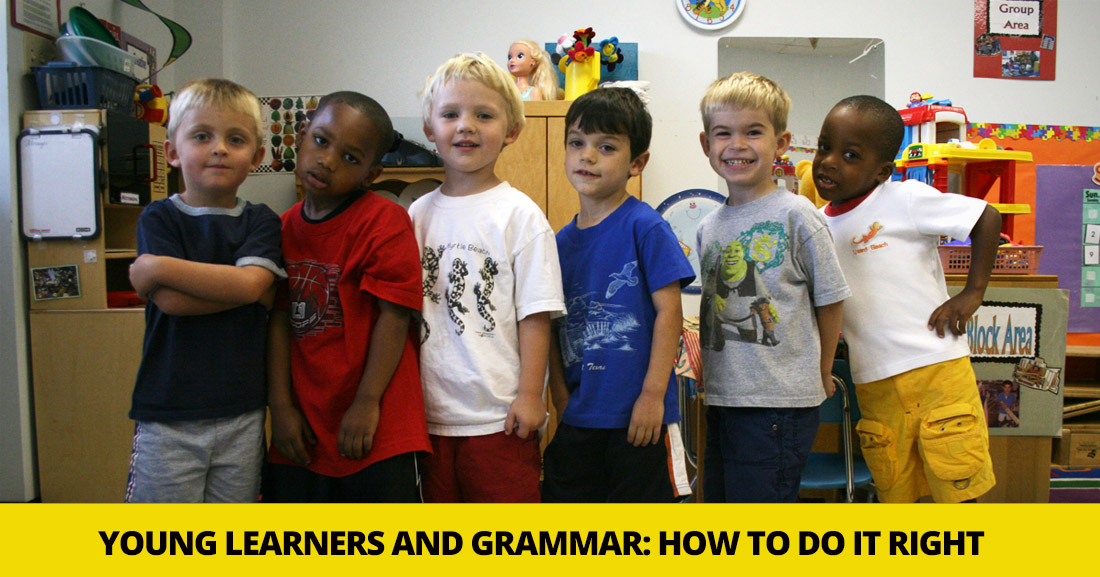Of all the things we teach, most would agree grammar is one of the most challenging.
The reason is because it is not easy to motivate students, especially young students to learn grammar . Simply sitting kids down and explaining rules is not an option because they possess certain characteristics that make their learning different from that of adults. In an ESL classroom, kids are in a setting in which they are surrounded by language. The second language is made meaningful because of the context and because of the way teachers speak to them. They have time to sort out the language that they hear and understand. When they are ready, they begin to use it to express themselves. Adults,on the other hand, usually focus more on learning vocabulary and grammar rules and they make an effort to apply those rules later. Here we see a clear difference between acquiring language and learning it. So, what do we need to do to teach young learners grammar?
Try These 4 Methods to Teach Grammar to Young Learners
-
1
It Needs to Be Clear
Children aren't good at understanding abstract concepts and grammar rules, specially young learners. That's why we need clear contexts that help them connect and associate with the language. One way to achieve this is through theme based instruction. It is important because in early language learning it provides an ideal environment for constructing meaning. In theme based teaching, the curriculum is organized around a theme. Then, within a thematic framework, all the language concepts are interrelated and presented as a whole. Teachers also need to adapt the language to the developmental level of the students and choose the activities to suit a variety of learning styles and multiple intelligences. The advantage is that by working around a theme students have many opportunities to find patterns and connections, experience attractive activities with varied content. All this facilitates interaction with other kids their age.
-
2
It Needs to Be Motivating and Interesting
While learning in general, students need to feel as if the are progressing but there also needs to be some challenge. If it's too difficult they will be disheartened and if it's too easy they will loose interest. Using games to teach grammar is an incredible option because they give kids an opportunity to interact with others in a natural way. This is important since the construction of meaning also has a social dimension, especially in a language classroom. Games, role-plays and group activities motivate students and enhance learning too. The social dimension of games and classroom rituals is another way in which the brain can attach meaning. The brain searches for meaning through patterning. It looks for patterns as it organizes information. Since young learners i search for meaning in the activities we provide for them, we must be sure to create meaningful experiences from which they construct their own patterns of understanding. Once the students have learned a concept, they can practice it in partners and small groups. The social relationships of partner and small group activities add to the richness of the learning experiences.
Here are some examples of simple activities that you can do with your young learners:
- As your lesson starts have the whole class greet you in the target language. After that the students can also greet one another in a very short, motivating activity.
- Have your students practice classroom dialogs with partners. You can also ask they “read”to each other a memorized story that they have read in class or written.
- Students can do a weather or traffic report. Give your kids some information about the weather or traffic that day. Simple words or sentences on the board are enough. Students then take turns telling their partners about the weather or traffic outside.
-
3
It Needs to Be Simple
Children have a limited amount of language at their disposal and this makes analyzing language difficult for them. Also the vocabulary needs to be simple and familiar so they can focus on the grammar they are learning. According to language acquisition, the language should be as simple and natural as possible. For instance, if the past tense is being taught, it shouldn't be postponed until students are able to analyze it. What is essential is whether the input is comprehended or not. The grammatical details of a message generally don't affect the comprehensibility. On the other hand, the context surrounding the verbal message and the vocabulary used to communicate it, affect comprehension much more,especially in the early stages of language acquisition. Making content meaningful and interesting for them may well be the most significant factors of all.
-
4
Review and Revise
Children need many opportunities to review and revise the language. This is to help them retain what they have learned and to feel confident. There are many activities that can be used to practice as well as review grammar. Reviewing doesn't have to be boring at all. Don't use the same activities you used to learn or practice. Make sure to use activities that are a bit different from others you used before and choose ones you are certain they will enjoy.
What we teach can certainly motivate our students to learn and also how well they retain.
We need to be very aware that it's not only what we teach but also how.
P.S. If you enjoyed this article, please help spread it by clicking one of those sharing buttons below. And if you are interested in more, you should follow our Facebook page where we share more about creative, non-boring ways to teach English.








